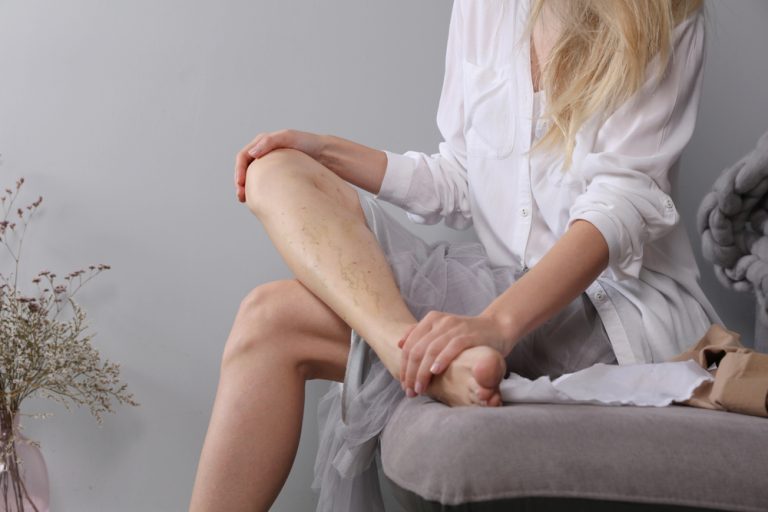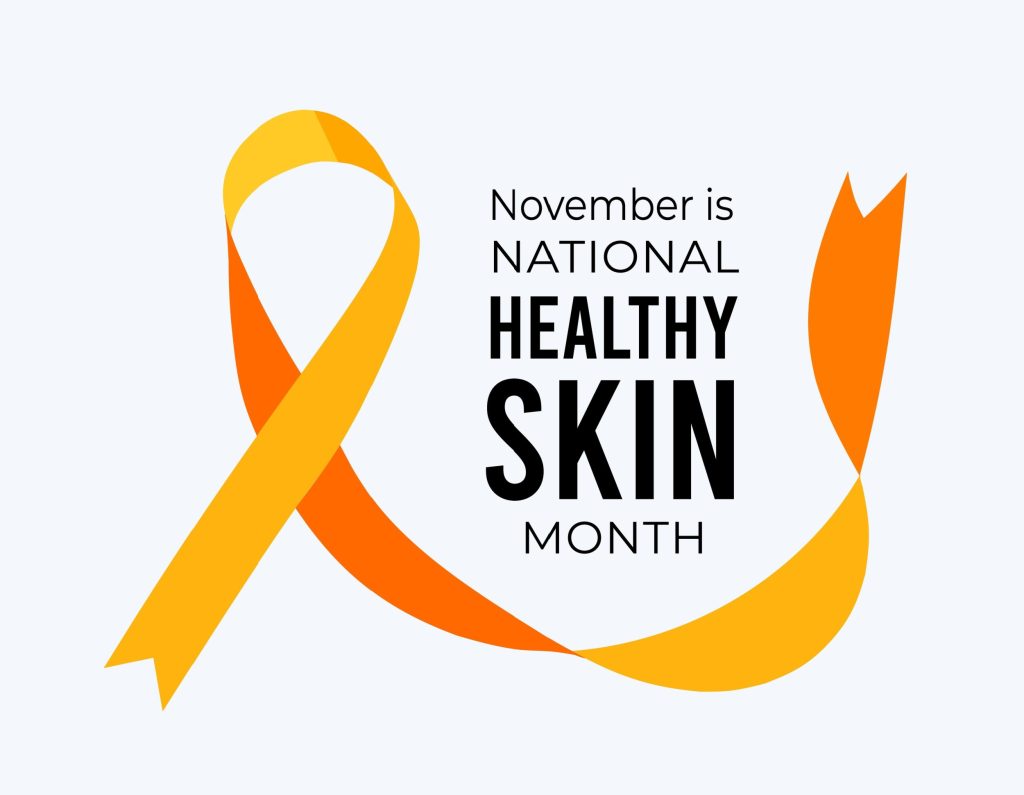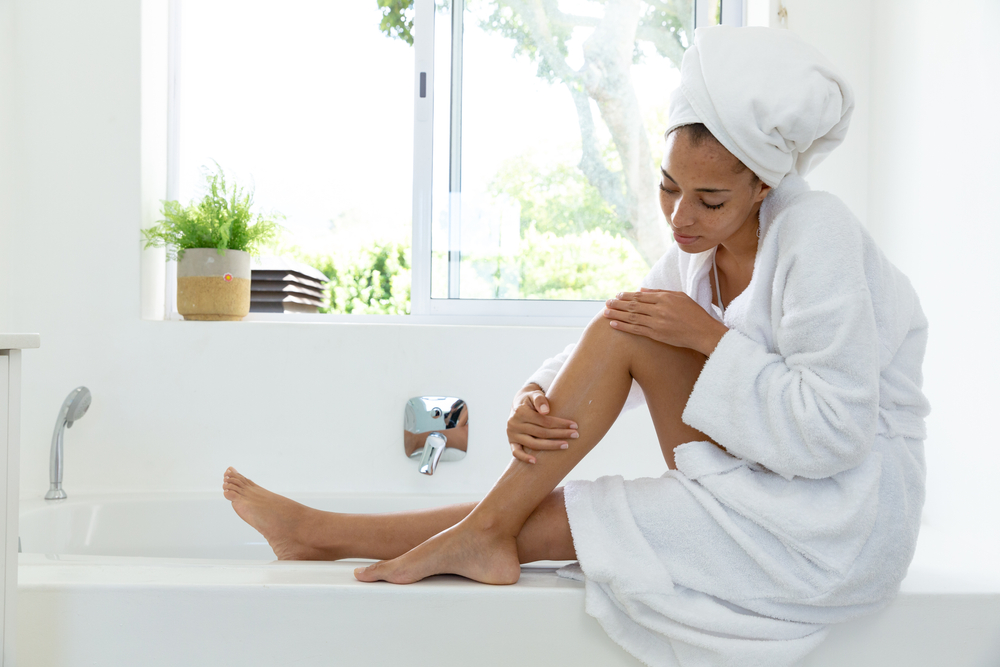
As you age, there’s a good chance you will have a run-in with varicose veins. These bumpy and raised blue or red veins form underneath your skin, especially around your legs or feet. Varicose veins develop when vein valves designed to push blood one way – upwards to the heart – weaken, fail, or become loose, and allow blood to flow back down the vessels and pool in the ankles and lower legs. Although the legs are the most common area to be affected, varicose veins can also appear in the arms and other body parts as well. You may also notice spider veins, which often precede thicker varicose veins. Spider veins are smaller, more delicate, and look like thin blue or red tracings that spread in a webbed pattern.
Anyone can develop varicose veins, and according to the American Society for Dermatologic Surgery, it is estimated that about 80 percent of women will present with some form of these varicosities by the age of 80. More women than men are affected.
Risk factors for developing spider or varicose veins include:
- Inheritance. You could simply have a genetic predisposition to weak vein valves.
- Hormonal fluctuations. Varicose veins are more common in women because puberty, pregnancy, menopause, and birth control can disrupt hormonal balance and cause vein valves to weaken. Pregnant women are especially susceptible, due to increased blood flow from the fetus, as well as having a full uterus on top of the thighs that stems the return of blood to the heart. If you develop pregnancy-related varicose veins, you can expect them to disappear or fade on their own in the postpartum stage.
- Prolonged periods of standing. Some occupations – such as nursing or teaching – carry a higher risk factor for development of these unpleasant veins because people in these fields spend most of the day on their feet.
Although protruding varicose veins or webbed spider veins can make you feel self-conscience, they are superficial and are typically not dangerous to your overall health. The working venous system runs deep under the surface of the legs and is not affected by the presence of superficial veins. In some cases, however, thick varicose veins can throb, swell, or feel leaden from the blood pooling into the legs. Other complications of varicose veins include vein inflammation, thrombosis, skin discoloration, skin irritation, or leg ulcers. It’s important to speak to a specialist to determine risks for these types of complications.
Because most varicose and spider veins are superficial, they can be removed without affecting leg circulation. Many people undergo vein treatments for cosmetic purposes because they do not like the appearance of varicose veins. Outside of aesthetics, varicose veins can also cause pain and inflammation, and many people opt for vein treatments to ease those symptoms of discomfort.
There are a number of treatment options available to remove spider and varicose veins:
- Ablation: Called thermal or radiofrequency ablation. This procedure involves having a thin catheter inserted into affected vein. The catheter is then heated by laser or radiofrequency waves, which break down collagen and destroy the vein wall. The vein collapses and is eventually reabsorbed back into the body. While effective, this treatment can cause bruising for a few days following the procedure, and it may take several weeks for the treated veins to be completely reabsorbed and disappear. And due to the high heat element, anesthesia is required during the procedure to numb the surrounding area and ease discomfort.
- Sclerotherapy: This is the treatment of choice for spider veins and small varicose veins. During this procedure, a solution is injected directly into the vein, causing the vein to swell and close. Blood flow will be rerouted into healthy veins, and the cut off varicose vein will eventually be reabsorbed back into body tissue. Solutions are often saline-based, but for larger veins, a detergent or emulsifier may be used as a foaming agent to swell and shut off affected veins. Sclerotherapy is a fast, minimally invasive treatment – it can be performed at your doctor’s office in less than an hour and does not require use of anesthesia.
- Phlebectomy: Also referred to as vein “stripping.” During this surgical procedure, the doctor will make several small incisions in the skin near the affected veins, and then strip each whole vein out of the area of concern. A Phlebectomy is generally still considered minimally invasive, and results are long-lasting because the entire vein is removed from the body.
- Surgery: For large, thick varicose veins, surgery may be required for removal. Before having a major varicose vein surgery, it is important to ask your dermatological surgeon appropriate questions about the risks, benefits, and expectations.
Outside of a medical procedure, there are many steps you can take at home to reduce the risk of developing varicose or spider veins.
- Wear compression stockings, which squeeze the legs and ankles to keep blood pumping steadily back to the heart. Be sure to have these ordered by your physician so they fit properly.
- Eat a healthy diet with lots of fiber to keep your circulation system strong. You should also maintain a healthy weight. Obesity hinders the body’s ability to keep blood flowing to the heart.
- Avoid standing and sitting for long stretches of time. Get up and walk at least once an hour if you sit for prolonged periods.
- Stay active. By engaging in activities like walking, cycling, and swimming, you can encourage blood circulation.
- Do not cross your legs while sitting – this puts pressure on the veins and cuts off circulation.
- Elevate legs to a level above the heart when resting.
- Be careful not to expose yourself to too much heat. Excessive heat from hot showers or baths and hot tubs can increase vein swelling and blood pooling.
If you are considering treatment for spider or varicose veins, speak with your dermatologist to determine the best option for your specific veins. Treatment recommendations vary based on the type and thickness of veins you are looking to remove, and some treatment plans may involve undergoing a combination of the procedures listed above.
If you suffer from varicose veins, your dermatologist can help you in making the best treatment decision.
Contact FLDSCC for All Your Skin Care Needs
Florida Dermatology and Skin Cancer Centers provides a full spectrum of dermatology and skin care services, and its team of physicians, APRNs, and PAs are experts in diagnosing and treating skin cancers with the latest technological options. Medical Director, Dr. K. Wade Foster, is fellowship-trained in Mohs surgery, the most effective technique for most types of skin cancers, with minimal scarring or risk.
For more information about services that Florida Dermatology and Skin Cancer Centers provides, or to make an appointment for a skin exam, visit www.fldscc.com or contact us at (855) FLD-SKIN.


